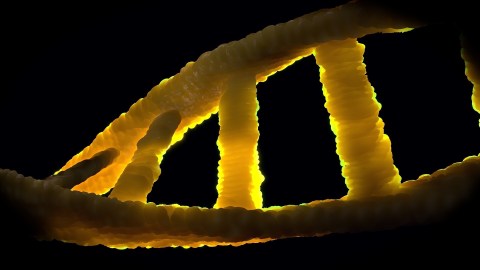New CRISPR tools can cut, splice whole chromosomes

Pixabay
- Until recently, the gene-editing tool CRISPR has only been able to make changes within single genes.
- The new tools allow scientists to cut and splice larger chunks of genetic material.
- The findings will likely have major implications for a variety of research fields, and also allow researchers to create synthetic species that can produce molecules not made by natural organisms.
Since 2012, the gene-editing tool CRISPR/Cas9 has enabled scientists to target and modify DNA with remarkable precision. But one constraint of this technique has been that it’s only able to make changes within single genes. Now, scientists have developed new tools that allow them to cut and splice large chunks of chromosomes, and to assemble new synthetic genomes from distinct strains.
The findings, published in a paper on August 30 in Science, likely have major implications for fields such as synthetic biology, computational biology, and biological computing, and could lead to better treatments for a wide array of diseases.
“This new paper is incredibly exciting and a huge step forward for synthetic biology,” Anne Meyer, a synthetic biologist at the University of Rochester in New York who was not involved in the paper, told Science.
Unlike previous gene-editing tools, the new tools are able to make many precise cuts to long strands of DNA without leaving any scarring.
The researchers, as Robert F. Service wrote for Science, also altered “another well-known tool, an enzyme called lambda red recombinase, so it could glue the ends of the original chromosome—minus the removed portion—back together, as well as fuse the ends of the removed portion. Both circular strands of DNA are protected from endonucleases. The technique can create different circular chromosome pairs in other cells, and researchers can then swap chromosomes at will, eventually inserting whatever chunk they choose into the original genome.”
“Now, I can make a series of changes in one segment and then another and combine them together. That’s a big deal,” Chang Liu, a synthetic biologist at the University of California, Irvine, told Science.
Why CRISPR Gene Editing Gives Its Creator Nightmares
The new tools will likely open the doors for scientists to explore many novel areas: create synthetic species that can produce molecules not made by natural organisms, write information into DNA for use as a storage device, and drive down the costs of medical research by making it easier to edit bacterial genomes on a larger scale.
However, using CRISPR to edit large sections of the human genome is unlikely to occur anytime soon, given the regulatory hurdles and ethical complications. After all, scientists aren’t fully aware of the consequences of making small edits to DNA, much less larger cuts.
“We don’t always fully understand the changes we’re making,” Alan Regenberg, a bioethicist at Johns Hopkins Berman Institute of Bioethics, told Science News. “Even if we do make the changes we want to make, there’s still question about whether it will do what we want and not do things we don’t want.”





